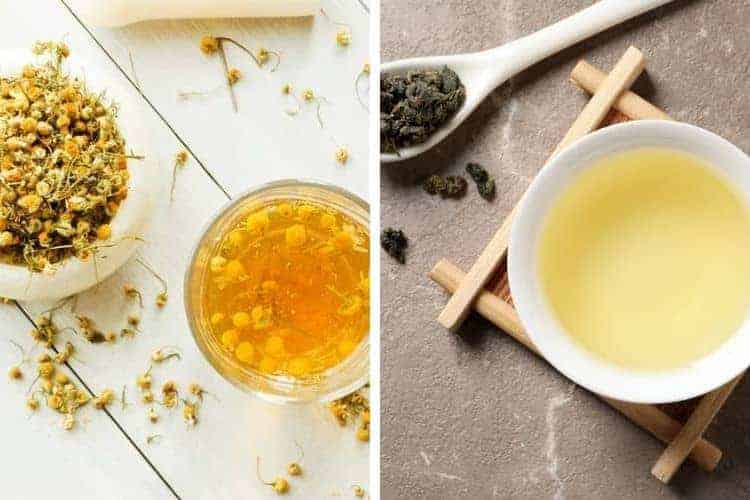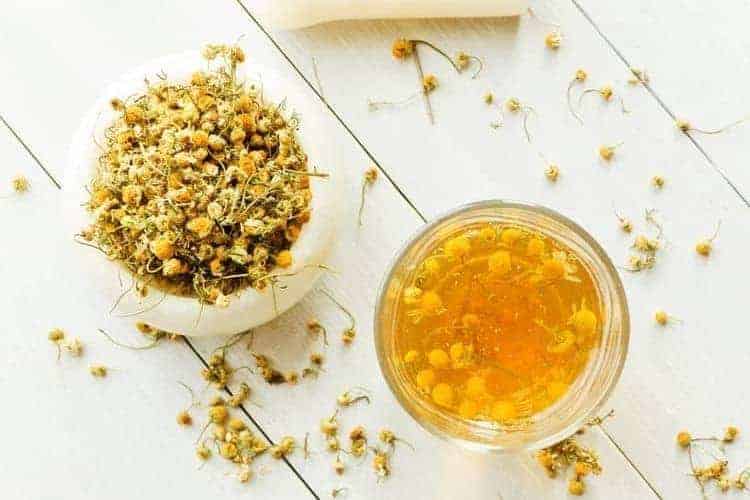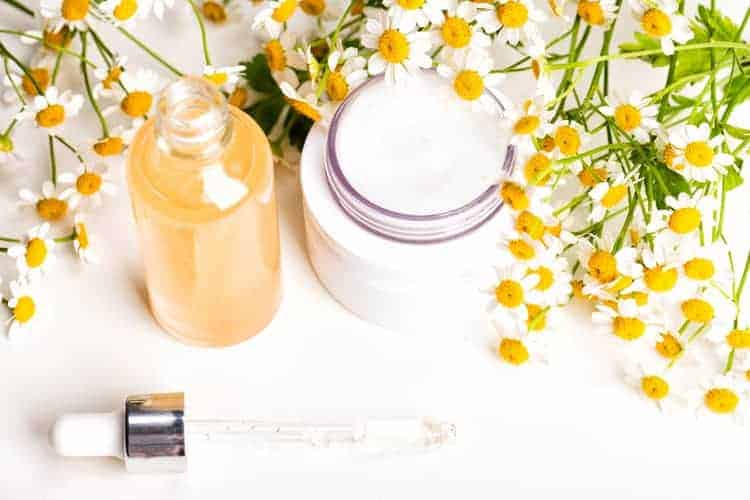
Let’s talk about chamomile tea vs green tea for acne. After all, both ingredients show up in a lot of products and they’re both praised for being incredibly beneficial for inflamed and super delicate skin. But is one better than the other, especially when it comes to acne?
Both chamomile and green tea have anti-inflammatory, antimicrobial and antioxidant properties that can soothe acne-prone skin. In fact, some research has shown that regular, topical use of green tea extract actually reduces the number of acne lesions.
While there aren’t any acne-specific studies for chamomile (at least none that I could find during my investigation) chamomile does have a long history of use for skin care.
So, in this article, I’m going to share with you:
- The main benefits and scientific research around chamomile and green tea for acne.
- How to incorporate these teas into your beauty routine.
- DIY tips and products that are worth looking into.
BENEFITS OF CHAMOMILE VS GREEN TEA FOR ACNE PRONE SKIN
| Chamomile Tea | Green Tea | |
|---|---|---|
| Anti-inflammatory | ✓ | ✓ |
| Antioxidant | ✓ | ✓ |
| Astringent | ✓ | ✓ |
| Antimicrobial | ✓ | ✓ |
Benefits of chamomile tea for the skin (source)

Anti-inflammatory:
- Chamomile has historically been used as a remedy for skin irritation, eczema, sunburns, rashes and other types of skin inflammation.
- Research indicates that the antioxidants and volatile (aka essential) oils in chamomile are able to penetrate into the deeper layers of skin, thus helping to soothe inflammation.
- Furthermore, Germany’s Commission E (similar to the FDA, but focused on herbs) approves topical use of chamomile for bacterial skin diseases, and inflammation of the skin (source).
Mild astringent
- Thanks to compounds known as tannins, chamomile is able to tighten pores.
Boosts wound healing
- Some studies indicate that topical application of chamomile can speed epithelialization, which is a natural process that restores the epidermis (top layer of skin) after it’s been injured.
Antioxidant-rich
- Antioxidants are an important part of any anti-acne skincare routine because they reduce inflammation, protect the skin from further damage and support skin renewal (essential for getting rid of scars, for example).
- Since chamomile is naturally rich in antioxidants, it stands to reason that applying it topically may help in improving the appearance of acne-prone skin.
Antimicrobial
- One study found that the essential oils in chamomile exhibit antibacterial properties against propionibacterium acnes (the bacterium that is said to contribute to the development of acne). Now, in case you’re wondering, those essential oils are also present in the tea (as long as you brew the tea properly; more on that later).
Benefits of green tea for the skin
Reduces acne lesions
- Some studies have shown that topical application of green tea extract leads to a significant reduction in non-inflammatory acne lesions (but there was no significant change in inflammatory lesions).
- More specifically, one study found that a 2% green tea lotion produced a 58.33% improvement in the number of mild to moderate acne lesions after 6 weeks (1, 2).
Antioxidant-rich
- Green tea is best known for packing a serious punch when it comes to antioxidants.
- The most abundant – and most studied – of those antioxidants is EGCG (epigallocatechin-3-gallate) which is part of a group of compounds called catechins.
Contains vitamins
- Some vitamins that are found in green tea include A, C and E. These vitamins are known for improving scarring, balancing skin tone and supporting skin renewal…
Antimicrobial and astringent
- Thanks to its caffeine content, green tea is able to act as an astringent.
- In addition, the catechins (a group of antioxidants) in green tea also have astringent and antimicrobial properties.
Soothes sensitive skin
- One of the main components of green tea is an amino acid called L-theanine.
- Research done with mice shows that topical application of L-theanine calms inflammation and reduces skin redness (source).
HOW TO USE CHAMOMILE AND GREEN TEA FOR ACNE

1. Use as a toner
The easiest way to incorporate green tea or chamomile tea into your skincare routine is to use them as a toner.
To do this, simply make the tea of your choice, let it cool down to room temperature and then apply it to your face with a cotton pad.
A few things to keep in mind when making these teas:
- For green tea, use 1 tea bag or 1 teaspoon loose leaf for every cup of water. 5 minutes of steeping is ideal.
- For chamomile tea, use 2 to 3 tea bags (or about 1 tablespoon dried flowers). Aim for 10 – 15 minutes of steeping time.
Keep in mind that you can also combine both teas into a blend. You’re not required to limit yourself to just one 🙂
In either case, make sure to use up the teas within 5 days.
NOTE: since very hot water can easily destroy delicate components like essential oils, you can use a cold infusion method to make chamomile tea. For this, simply place the herbs in cold water, cover and let sit overnight. That’s it! Do keep in mind that the cold method doesn’t extract tannins (which is one of the things that gives chamomile it’s astringency). Yep, no one method is perfect so experiment with both hot and cold.
2. Make an acne-fighting face mask
In many cases, you can substitute brewed tea for the liquid in masks, including clay masks. So, if you enjoy whipping up your own masks, consider using green or chamomile tea as your liquid.
Also, keep in mind that when it comes to green tea, the powder form aka matcha, is often a better and more potent option for masks.
For a quick matcha-based recipe that you can use, as well as more about how it differs from regular green tea, read this guide on green tea vs matcha for skin.
3. Drink on a regular basis
Even though you can apply chamomile and green tea to your face, their true power really comes through when we drink them.
So don’t hesitate to make them a regular part of your diet.
For example, consuming chamomile tea helps to:
- Support gut health (which is often linked to acne).
- Regulate blood sugar (another major factor that can drive breakouts).
As for green tea, it’s reputation as an antioxidant and anti-inflammatory drink has been well established (both anecdotally and scientifically).
So, don’t hesitate to drink one or both of these teas on the regular for clearer skin from the inside out!
Besides the DIY options mentioned above, you can find green tea and chamomile in lots of skin care products. Here are a couple to check out:
Mad Hippie Vitamin C Serum: this serum combines gentle vitamin C derivatives with chamomile flower extract, hyaluronic acid, aloe vera leaf and other soothing plant-based derivatives. GET IT HERE.
Herbivore Jasmine Green Tea Toner: a soothing blend of green tea extract, aloe leaf water, jasmine water and oat extract. GET IT HERE.
CAN CHAMOMILE OR GREEN TEA CAUSE ACNE?
Even though there’s no research showing that chamomile or green tea cause acne, it’s possible to have an allergic reaction to either one of them (as with any other plant). That allergic reaction could present itself in many different ways, including skin irritation.
One thing to note is that chamomile is part of the ragweed family.
So, if you have a ragweed allergy, you may find that drinking the tea or using it topically causes a reaction.
FAQs ABOUT USING GREEN TEA AND CHAMOMILE FOR PIMPLES
What type of tea is best for acne?
Some teas that may help with acne include:
- spearmint.
- hibiscus.
- ginger.
- dandelion tea.
These teas have different courses of action that address the various factors that contribute to acne.
For example, spearmint tea has been shown to reduce testosterone, and therefore may help with hormone-induced acne.
Dandelion, on the other hand, supports liver detoxification, allowing the body to get rid of toxins that are contributing to inflammatory conditions like acne.
CONCLUSION
Given that acne is usually caused by various factors, it’s worth using remedies that can address those different factors.
Green tea and chamomile tea are dual-purpose remedies that you can use topically and also consume internally.
This makes it easier for you to address the underlying inflammation of acne at the surface as well as the, deeper root level.
You Might Also Enjoy:
Peppermint Tea vs Spearmint Tea for Acne: Which Is Better?
A Comparative Guide to Green Tea vs Spearmint Tea for Acne
Is Chamomile Tea Good For Acne? Here’s The Truth
How Much Water Should I Drink To Get Rid Of Acne? The Answer May Surprise You
Spearmint Tea vs Spironolactone for Acne: Pros and Cons | Is One Better Than The Other?
What No One Is Telling You About Stevia and Acne
Why Is My Skin Bad When I Eat Healthy? 8 Reasons You May Not Have Considered
How To Make The Best Anti-Acne Smoothie To Give Your Skin New Life
Is Chamomile Oil Good For Acne? Complete Guide With Tips and Recipes

